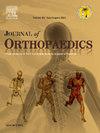Temporal and regional trends of fractures in the United States: A review of the global burden of disease database
IF 1.5
Q3 ORTHOPEDICS
引用次数: 0
Abstract
Background
Musculoskeletal diseases, including bone fractures, are a significant contributor to global disability. Understanding temporal and regional trends in bone fractures is crucial for effective healthcare planning and resource allocation. We sought to analyze recent epidemiological trends of different types of fractures in the United States and determine correlations and associations between fracture trends and potential influencing demographic factors (i.e. age, sex, regional-specific).
Methods
Data from the Global Burden of Disease Database were analyzed to examine fracture incidence, prevalence, and years lived with disability (YLDs). Statistical analyses were conducted to determine temporal trends and sex-based differences.
Results
The analysis revealed significant increases in hip fractures and decreases in pelvic fractures over time. Fractures of the patella, tibia, fibula, and ankle remain prevalent across all regions and sexes, with notable variations.
Conclusions
These findings underscore the importance of targeted interventions and resource allocation to address the burden of fractures on public health. Despite limitations, this study provides critical insights into fracture epidemiology, guiding future prevention and management strategies.
美国骨折的时间和区域趋势:全球疾病负担数据库的回顾
包括骨折在内的肌肉骨骼疾病是导致全球残疾的一个重要因素。了解骨折的时间和区域趋势对于有效的医疗保健计划和资源分配至关重要。我们试图分析美国不同类型骨折的近期流行病学趋势,并确定骨折趋势与潜在影响人口因素(如年龄、性别、地区特异性)之间的相关性和相关性。方法分析来自全球疾病负担数据库的数据,检查骨折发生率、患病率和残疾生活年数(YLDs)。进行统计分析以确定时间趋势和基于性别的差异。结果分析显示,随着时间的推移,髋部骨折显著增加,骨盆骨折显著减少。髌骨、胫骨、腓骨和踝关节骨折在所有地区和性别中仍然普遍存在,且存在显著差异。结论这些发现强调了有针对性的干预措施和资源分配对于解决骨折对公共卫生的负担的重要性。尽管存在局限性,但该研究为骨折流行病学提供了重要见解,指导了未来的预防和管理策略。
本文章由计算机程序翻译,如有差异,请以英文原文为准。
求助全文
约1分钟内获得全文
求助全文
来源期刊

Journal of orthopaedics
ORTHOPEDICS-
CiteScore
3.50
自引率
6.70%
发文量
202
审稿时长
56 days
期刊介绍:
Journal of Orthopaedics aims to be a leading journal in orthopaedics and contribute towards the improvement of quality of orthopedic health care. The journal publishes original research work and review articles related to different aspects of orthopaedics including Arthroplasty, Arthroscopy, Sports Medicine, Trauma, Spine and Spinal deformities, Pediatric orthopaedics, limb reconstruction procedures, hand surgery, and orthopaedic oncology. It also publishes articles on continuing education, health-related information, case reports and letters to the editor. It is requested to note that the journal has an international readership and all submissions should be aimed at specifying something about the setting in which the work was conducted. Authors must also provide any specific reasons for the research and also provide an elaborate description of the results.
 求助内容:
求助内容: 应助结果提醒方式:
应助结果提醒方式:


